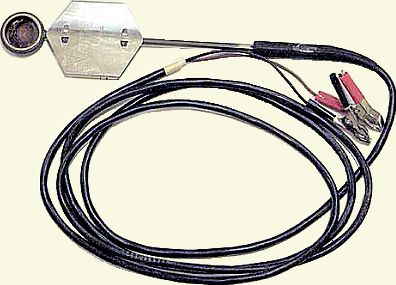Thorne Beehives
Varrox Website
|
|
|
|---|
Varrox Evaporator Instruction Leaflet
as Re-Written by Dave Cushman
Also known as Varrox vaporiser, but this page will only use the term Varrox evaporator.
|
Thorne Beehives Varrox Website |
Varrox Evaporator Instruction Leaflet
|
|---|
This Instruction leaflet is written from the point of view of UK beekeepers, using terminology understood in UK, rather than an English translation from another language. I have no connections, with Varrox, BioVet or Thornes, nor do I promote or denigrate the use of this product. You should establish that it's use is legal in your own area or country and take notice of the warnings regarding oxalic acid. If, however, anyone reading this version does not agree with my interpretation of the text on the original leaflet, please get in touch and the text can be changed, because that may help others.
|
The device itself, consists of a metallic pan surrouded by a heating element, the connections for this element are passed through a rigid portion of handle which has large hexagonal wings to ensure that the pan stays horizontal when inserted into the hive. Connection is made to a battery or other energy source, via a three metre long cable with either battery clips or a car cigarette lighter type plug. The one at right is the battery clip version. |

|
|---|
|
General license and distribution: 1. Appliance The VARROX-evaporator consists of a heater, a metallic support and 3 .m of lead with 2 battery- clips. It has an output or 150 W. The power source can either be a 12v car battery of 40 Ah or more, other type of accumulator, or a car cigarette lighter used with a seven metre extension lead.
Please note safety precautions ! Wear a protective mask ! 2. Mode of action A measured quantity of oxalic acid crystals are placed in the pan, then the appliance is inserted through the entrance of the hive, into the middle of the bottom of the hive, keeping the pan horizontal to prevent spillage of crystals. The insertion should be far enough so that the hexagonal metallic support is fully inside the entrance. If bees are clustered over the pan, they must be strongly encouraged to disperse into the interior of the hive by using smoke. The power is switched on and the heating action of the pan causes the oxalic acid to vaporise. The oxalic acid vapour pervades the hive and all the exterior of the bees and hive surfaces are covered by a deposit of a very thin layer of oxalic acid crystals. These fine crystals are tolerated well by the bees, but have a deadly effect on varroa mites. 3. Treatment
Time Dosage The dose varies according to how strong the hive is... one gram of oxalic acid-dihydrate per full sized brood box. The measuring spoon supplied with Each VARROX-vaporiser, if filled with loosely and without compaction, corresponds to one gram of Oxalic acid-dihydrate. So use one spoonfull per brood box. In the case that a hive comprises a brood and a half arrangment of one brood box plus a super, then one and a half sponsful would appear to be a good compromise.
Placing the VARROX-vaporiser Hint: Depending on the height of the entrance and the bottom of the hive, it is recommended to fit the VARROX-vaporiser in evenly by bending down both sides of the metallic support a few millimetres. The distance between the bottom of the hive and the heating element can be increased and the source of the heat is taken off the bottom. Attention: Due to the heating action of the pan, there is a danger of melting plastified varroa bars and synthetic hives. The VARROX-vaporiser reaches temperatures of up to 300°C and can create patches of heat on the bottom and frames.
Sealing up the hive
Duration of the treatment Hint: With the use of several VARROX-vaporisers, bigger apiaries can be treated more time-effectively. 4. Oxalic acid-dihydrate (Oxalic acid-crystals) Oxalic acid is an unhealthy, toxic and corrosive substance. When filling the VARROX-vaporiser and during the treatment, it is absolutely necessary to wear protective glasses, a protective mask (FFP 3 S/L), gloves and long-sleeved clothes. Working safety Handling of oxalic acid
In the case of eye contact. immediately wash the acid out with water. If ingested immediately go to a doctor. Working safety during the treatment
Purchase of oxalic acid-dihydrate For the treatment, oxalic acid-dihydrate (C2H2O4 x 2 H20) CAS-No. 6153-56-6. EG-No. 205-634-3 has to be used. Normally available in pharmacies. 5. Concept of control
Treatment in brood free colonies
Treatment of swarms / artificial swarms
Treatment of nucleus Accessories
Electrical supply
Source of troubles
After the treatment there is still some acid left in the pan Warranty Please, follow the instruction of use carefully. We do not assume any warranty for wrong application, reasons of unsatisfied efficacy or possible damages that are beyond the control of Andermatt BIOCONTROL AG. |
|
It cannot be stressed too strongly that oxalic acid is an aggressive substance and needs to be treated with respect. Acid resistant gloves and goggles should be worn and an apron of the type used by mortuary attendants, along with wellington boots that have the tops covered by gaiters so that any falling liquid cannot fall into the boot. A respirator that has specialised organic acid filtering will be required in cases where the acid is sprayed or vapourised. Oxalic acid is also poisenous to humans by ingestion. |
Originally written by Dave Cushman.
Page created 05/11/2005
Page updated 21/08/2022